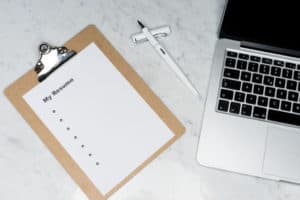Does the thought of crafting your first resume or cover letter fill you with a sense of dread? You’re not alone. Many step into the world of job applications feeling like they’re expected to know the ropes without ever having been shown them. It can feel like trying to decipher a map without any legend, especially when advice online oscillates between the outdated and the overly trendy.
Fear not. This blog aims to be the compass you didn’t know you needed, guiding you through the creation of entry-level resumes and cover letters with clarity and confidence.
Quick Takeaways:
- Use clean, professional templates and include a touch of color to make your resume visually appealing.
- Tailor your resume and cover letter for each job by highlighting relevant skills and experiences.
- Include quantifiable achievements and utilize active language to demonstrate your impact and initiative.
What Makes a Great Entry-Level Resume?
When you’re stepping into the professional world, your resume is your handshake before you’ve even entered the room. It needs to be crisp, clear, and most importantly, memorable. For an entry-level resume, emphasizing clarity and relevance is key. You might not have years of direct experience, but you’re not without skills or achievements.
Firstly, focus on layout and formatting. Use a clean, professional template that allows for easy scanning. Tools like Canva offer free resume designs that stand out while maintaining a professional appearance.
Highlight transferable skills . Perhaps you led a project in your university club or managed a small online business. These experiences, while not directly related to the job you’re applying for, showcase leadership, project management, and entrepreneurship — valuable in any role.
Tailor your resume to the job description. This doesn’t mean sending a completely new resume to every employer but tweaking it to highlight the experience and skills most relevant to each position.
Quantify achievements when possible. Instead of saying you “significantly increased club membership,” specify “increased club membership by 40% through targeted social media campaigns.” It gives a tangible measure of your impact.
Remember, at the entry-level, passion, eagerness to learn, and transferable skills can often weigh as much as, if not more than, direct experience.
How Can You Make Your Cover Letter Stand Out?
In a sea of similarly qualified candidates, your cover letter is your voice. It allows you to tell your story, convey passion, and connect with the recruiter on a human level.
Start with personalization. Address the letter to the hiring manager by name whenever possible, showing you’ve done your homework. If the job listing doesn’t include a name, LinkedIn or the company’s website can often help you find it.
Tell a story . Perhaps you’re applying for a marketing role and you have a personal blog that saw exponential growth because of your unique strategy. This not only shows your skills but also your enthusiasm and personal connection to the field.
Explain why you’re a good fit for the company — not just the role. Research the company’s culture, mission, and recent achievements. Relate those to your own values and experiences, demonstrating how you align with them beyond just the job requirements.
One unique tip that often goes under the radar: Link to a personal project or an online portfolio. This could be anything from a GitHub repository if you’re in tech, to a personal blog or a digital art portfolio. It provides immediate, tangible evidence of your skills and passion.
What Are Common Mistakes to Avoid?
When crafting your entry-level resume and cover letter, a few common slip-ups could stand between you and your dream job. Let’s ensure you dodge those bullets.
Avoiding personalization in the cover letter . Generic letters are a dime a dozen. Make your application memorable by connecting your personal story to the company’s goals.
Ignoring keywords from the job description . Many companies use applicant tracking systems (ATS) to screen resumes before a human eye sees them. If your resume doesn’t include keywords from the job listing, it might never make it to a recruiter.
Being too lengthy or verbose . Your resume should ideally be one page, certainly no longer than two for an entry-level position. Your cover letter should not exceed one page. Be concise and to the point.
One mistake rarely mentioned is neglecting to use active language. Phrases like “was responsible for” are passive and less impactful. Instead, use action verbs such as “managed,” “created,” “initiated,” and “implemented” to describe your experiences and achievements.
And, perhaps surprisingly, a lack of proofreading can torpedo your chances. A resume or cover letter with typos, grammatical errors, or inconsistent formatting sends a message of carelessness. Always double-check your materials or have a friend review them before submitting.
In today’s competitive job market, your entry-level resume and cover letter are crucial tools in making a strong first impression. By employing these targeted strategies, you’ll not only stand out from the crowd but also take a significant step towards landing that coveted position.
How Important Is Layout and Design?
First impressions are not just about how you carry yourself in person; they extend to your resume and cover letter too. The visual appeal of these documents plays a pivotal role in capturing the attention of hiring managers who may be sifting through dozens, if not hundreds, of applications. Here’s the scoop: a cluttered, unorganized layout sends the message that you might be just as disordered in your professional life. But don’t fret! Let’s unravel the art of creating visually appealing and professional layouts that make hiring managers take notice.
Keep It Sleek and Professional
- Font Choices: Stick to classic, easy-to-read fonts like Arial, Calibri, or Times New Roman. While it might be tempting to go for something more distinct, remember that readability trumps uniqueness in this realm.
- White Space is Your Friend: Clutter is the enemy of clarity. Ensure your resume breathes by leaving adequate margins (around 1 inch) and spacing between sections.
- Consistent Formatting: Use bullet points, bolding, and italics judiciously to highlight crucial information without overwhelming the reader.
A well-thought-out design is not just about aesthetics; it enhances readability, ensuring that your strengths and qualifications are effortlessly discernible.
The Road Less Traveled Tip
Here’s a gem that’s often overlooked: consider adding a touch of color. Now, we’re not talking about turning your resume into a rainbow. Instead, a subtle use of color for headings or borders can make your document stand out from the sea of black-and-white submissions – just ensure it remains professional and doesn’t detract from the content.
Customize Your Application: How and Why?
“Spray and pray” might work for watering your garden, but it’s a dismal strategy for job applications. Taking the time to tailor your resume and cover letter for each position is crucial. Why? Because it demonstrates to the employer that you’re not just looking for any job – you’re interested in this job.
Making the Cut
Here’s how you can customize effectively:
- Research: Thoroughly research the company and the role. Understand their values, culture, and what they seek in a candidate.
- Tweak Your Objective or Summary: Your resume’s objective or summary should echo the language and the requirements of the job description. It’s your chance to say, “Hey, I’m what you’re looking for.”
- Highlight Relevance: Emphasize your skills and experiences that are most relevant to the position. Got a project or course that aligns perfectly with the job? Make sure it’s front and center.
The Match Game
Now, here’s a tip that’s pure gold and isn’t shouted enough from the rooftops: Create a matrix. On one side, list the key skills and qualifications the job post mentions. On the other, note your experiences and skills. Then, draw lines to match them up. This simple exercise not only helps you tailor your resume but also prepares you for interviews by making clear why you’re a great fit.
Remember, at the end of the day, your entry-level resume and cover letter are your professional introductions — your chance to make a compelling first impression. By focusing on a clear, professional layout and diligently customizing your application to each job, you communicate not only your qualifications but also your dedication and attention to detail. This one-two punch can be just what’s needed to land you that interview.







![How Long to Wait Before Accepting a Job Offer? [Full Guide] person speaking on smartphone while looking at paper](https://howmonk.com/wp-content/uploads/2022/04/person-speaking-on-smartphone-with-paper-300x200.jpg)